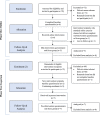Feasibility of a peer-led, after-school physical activity intervention for disadvantaged adolescent females during the COVID-19 pandemic: results from the Girls Active Project (GAP)
- PMID: 36042503
- PMCID: PMC9425823
- DOI: 10.1186/s40814-022-01149-2
Feasibility of a peer-led, after-school physical activity intervention for disadvantaged adolescent females during the COVID-19 pandemic: results from the Girls Active Project (GAP)
Abstract
Introduction: There is a critical need for interventions that can be feasibly implemented and are effective in successfully engaging adolescent females in physical activity (PA). A theory-based, peer-led, after-school PA intervention, the Girls Active Project (GAP), was codesigned with adolescent females. This study aimed to assess the feasibility of implementing and evaluating the GAP programme.
Setting: One single-sex, female-only, designated disadvantaged postprimary school (students aged 12-18) in Dublin, Ireland.
Methods: Mixed methods were applied with multiple stakeholders over a 12-week trial (March to May 2021). A single-arm study design was used to examine intervention: reach, dose, fidelity, acceptability, compatibility and context. Feasibility of using proposed self-reported outcome measures (moderate-to-vigorous PA levels, self-rated health, life satisfaction, PA self-efficacy and PA enjoyment) was also explored. Due to school closure resulting from the COVID-19 pandemic, the intervention was delivered both online and in person in the school setting.
Results: Eight exercise classes were peer delivered by project leaders (n = 6, students aged 15-17) to intervention recipients (students aged 13-14). Recruitment was low (n = 8, 10% of eligible students, mean age: 13.3 SD: 0.46), yet retention was high (n = 7/8, 88%). Attendance rates were satisfactory (68%), and the intervention was implemented with high fidelity (87%). Data completion rates suggested proposed self-reported outcome measures were deemed appropriate (≥ 95%), except for weight (50%) and height data (80%). Despite COVID-19 hindering intervention implementation, both quantitative and qualitative data suggested that stakeholders were satisfied and perceived the in-person delivered intervention to be compatible with the school setting. Recommended refinements included extending class duration, introducing different rewards, and boosting programme awareness.
Conclusions: Further thought must be given on how to increase recruitment. Overall, the in-person delivered after-school PA programme was well-received by stakeholders and shows promise as an intervention that can be feasibly implemented and evaluated. Suggested improvements to the GAP intervention programme are recommended, before continuing to a more robust evaluation.
Trial registration: 10.17605/OSF.IO/75HWJ (prospectively registered, date of registration: 9th December 2020).
Keywords: Adolescents; Behaviour change; COVID-19; Feasibility; Female; Implementation; Intervention; Mixed methods; Peer led; Physical activity; School.
© 2022. The Author(s).
Conflict of interest statement
The authors declare that they have no competing interests.
Figures
Similar articles
-
A process evaluation of the walking in ScHools (WISH) study using the RE-AIM framework.BMC Public Health. 2025 Mar 3;25(1):844. doi: 10.1186/s12889-025-21434-y. BMC Public Health. 2025. PMID: 40033298 Free PMC article.
-
Co-design of a school-based physical activity intervention for adolescent females in a disadvantaged community: insights from the Girls Active Project (GAP).BMC Public Health. 2022 Mar 29;22(1):615. doi: 10.1186/s12889-022-12635-w. BMC Public Health. 2022. PMID: 35351045 Free PMC article.
-
A process evaluation of the PLAN-A intervention (Peer-Led physical Activity iNtervention for Adolescent girls).BMC Public Health. 2019 Sep 2;19(1):1203. doi: 10.1186/s12889-019-7545-z. BMC Public Health. 2019. PMID: 31477088 Free PMC article.
-
A peer-led walking intervention for adolescent girls (the WISH study): a cluster-randomised controlled trial.Lancet. 2023 Nov;402 Suppl 1:S72. doi: 10.1016/S0140-6736(23)02076-7. Lancet. 2023. PMID: 37997117 Clinical Trial.
-
Cue-based versus scheduled feeding for preterm infants transitioning from tube to oral feeding: the Cubs mixed-methods feasibility study.Health Technol Assess. 2021 Dec;25(74):1-146. doi: 10.3310/hta25740. Health Technol Assess. 2021. PMID: 34878383
Cited by
-
Strategies for recruitment of adolescent girls into physical activity programmes: a systematic review protocol.HRB Open Res. 2024 Dec 24;7:6. doi: 10.12688/hrbopenres.13834.2. eCollection 2024. HRB Open Res. 2024. PMID: 39494245 Free PMC article.
-
Findings from a cluster randomised feasibility study of a school-based physical activity role model intervention (CHARMING) for 9-10-year-old girls.Pilot Feasibility Stud. 2025 Apr 4;11(1):38. doi: 10.1186/s40814-025-01615-7. Pilot Feasibility Stud. 2025. PMID: 40186260 Free PMC article.
-
Understanding Drug and Alcohol Staff Perspectives on the Barriers and Facilitators to Drug Checking: A Qualitative Study.Drug Alcohol Rev. 2025 Jul;44(5):1330-1338. doi: 10.1111/dar.14073. Epub 2025 May 4. Drug Alcohol Rev. 2025. PMID: 40320763 Free PMC article.
-
A process evaluation of the walking in ScHools (WISH) study using the RE-AIM framework.BMC Public Health. 2025 Mar 3;25(1):844. doi: 10.1186/s12889-025-21434-y. BMC Public Health. 2025. PMID: 40033298 Free PMC article.
References
-
- Inchley J, Currie D, Budisavljevic S, Torsheim T, Jåstad A, Cosma A. Spotlight on adolescent health and well-being. Findings from the 2017/2018 Health Behaviour in School-aged Children (HBSC) survey in Europe and Canada. International Report. Volume 1. Key Findings. Copenhagen: WHO Regional Office for Europe; 2020.
Grants and funding
LinkOut - more resources
Full Text Sources
Miscellaneous


